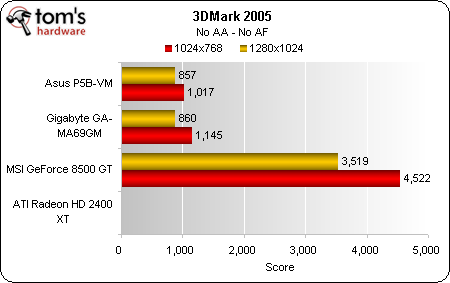Integrated Graphics for Gaming or HTPC?
The Game Tests
As mentioned above, we wanted to see what these integrated graphics devices could do with some demanding titles from a few years ago. While these can still be tough for entry-level graphics cards, the point of having an integrated chipset with a graphics device is to replace the need for an entry-level card in addition to the purchase of a motherboard. For comparison we used 3DMark 05 for a synthetic test, Doom 3 for OpenGL performance and F.E.A.R. for DirectX 9 performance.
Doom 3 was released 3 August 2004 with the debut of Nvidia's 6600 GT. For its time it was the nastiest thing one could do to a computer using OpenGL. With successive graphics engines from ATI and Nvidia, Doom 3 was tamed and is no longer limited by the graphics processor except at high resolutions with antialiasing enabled. F.E.A.R. debuted 18 October 2005. The game introduced a shader effect called soft shadows. This is a technique that softens shadowed surface edges, giving the appearance of how we see real shadows cast. This additional post processing chewed up existing hardware. Much like Doom 3, newer-generation graphics cards were able to handle the additional computations and were hindered more by antialiasing at higher resolutions than by soft shadows.
Seeing as these game titles are two and three years old, how did the integrated chipsets fair? In a single word: poorly. That is the nicest term we can say about both chipsets for real-world game applications. We did the same tests that we do for all of the discrete graphics cards that pass though our labs and we didn't want to be less lenient on them just because they were integrated. According to Valve Software's Steam Survey, 76% or roughly 847,000 of its 1 million plus participants have a screen resolution at either 1024x768 or 1280x800. These are the default resolutions for most monitors on the market. We ran our two tests at a 4:3 aspect ratio of 10x7 and 12x10 since all CRT and LCD monitors can display these resolutions.
The integrated chipsets took a beating from the $75 graphics cards. Neither of these graphics cores have hardware vertex processors. That work is being handled by the CPU. Also, the memory and data transfer bandwidth of the integrated chipsets is far more limited compared to the discrete graphics cards. This will factor into all of the game related results.
3DMark 05
Looking at the motherboards, the AMD 690 chipset with the X1200 graphics core did a little better than the Intel X3000. Either way, both integrated chipsets did not perform well. If you want to equate performance in terms of the score, it is the same level of performance we achieved with an Nvidia FX 5800/5900 over two years ago. As far as discrete cards go, the MSI GeForce 85000GT based TD256E has the clear lead over nothing. For some unknown cause, there was an issue with 3DMark05 that would lock the system. After repeated attempts to reinstall the OS, drivers, application and lock down the integrated and discrete cards in the BIOS, we ended up with the same lockup. This is why you do not see a score for 3DMark05 for the HD 2400XT.
Get Tom's Hardware's best news and in-depth reviews, straight to your inbox.
